|
The first troops to
serve in Australia were four specially raised companies of the Marine
Corps, which arrived with the First Fleet in 1788.
In 1792 the Marine
garrison was relieved by the New South Wales Corps which, between 1800
and 1810, was
supported
by local volunteer forces at Sydney and Parramatta, known as loyal
Associations.
These were the first military forces to be raised in
Australia, and elements of these associations took part with the New
South Wales Corps in suppressing the abortive convict uprising of 1804.
Through its alliance with the Royal Marines and its descent from these
first New South Wales citizen soldiers, the Royal New South Wales
Regiment has links which go back to the first days of settlement in
Australia and these links are proudly commemorated in the Regiment's
motto, "First in Australia"
From time to time
through out the intervening years, proposals were made for the raising
of local volunteer forces to assist in defence of the Colony.
It was not
until 1854, however, that The Sydney Volunteer Rifles was formed.
|
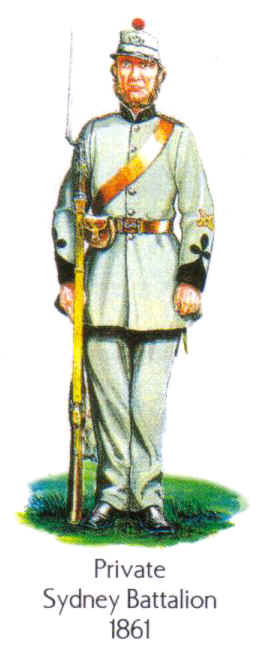 |
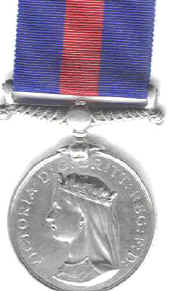
|
This is the ancestral
corps from which many infantry battalions associated with New South
Wales are descended.
The Waikato War of
1863-1864 led to an active recruiting campaign by the New Zealand
Government in the Australian Colonies, a fertile field being the various
Volunteer units.
New South Wales Volunteers served, as individuals, in
each of the four Waikato Regiments.
Most did not return to Australia,
taking up the New Zealand land grants offered for service against the
warlike Waikato tribes.
<<
Medal for the New Zealand War |
|
In 1885 the first Australian force to be formed
specifically for service overseas was raised. This was the New South
Wales Contingent to the Soudan.
As a result of its service, the Honorary
Distinction 'Suakin 1885' was granted in 1907 to several infantry
regiments, to be borne for their Colonial era predecessors.
Kedhives Star from the Soudan
Campaign >> |
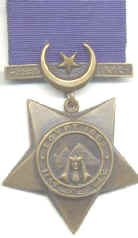 |
|
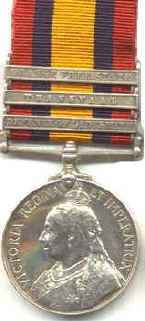
|
At the outbreak of the
second Boer War in 1899, there were eight infantry regiments and several
supplementary infantry corps in the New South Wales Military Forces.
Initially, a small infantry contingent was raised and sent to South
Africa. Subsequent volunteer drafts served as mounted infantry, for
which the need was greatest.
The Battle Honour 'South Africa,
1899-1902' is carried by the Regiment for its colonial forebears.
<<<
Queen's South Africa Medal
|
|
In July 1900 a small
detachment, the New South Wales Marine Light Infantry, was recruited
from local volunteers of the Third Contingent (awaiting movement to
South Africa) to provide an infantry component for the New South Wales
Naval Contingent which was being hurriedly formed for service in China
during the Boxer Rebellion.
China
Medal >>
Like their predecessors in the Soudan in
1885, these troops saw little fighting but spent much time on active
service in harsh conditions amidst a hostile population.
|
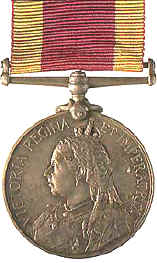 |
In 1903 the military
forces of the former Australian colonies were amalgamated to form the
Australian Army. The Infantry and Light Horse Regiments then adopted
territorial titles. Australia's commitment overseas during the Great War
1914-1918 required the raising of a special expeditionary force.
Designated the Australian Imperial
Force (AIF), its formations were deployed
in the Middle East, Turkey, France and Flanders. A smaller naval and
military expeditionary force (AN&MEF) served in New Britain from shortly after
the outbreak of war.
Twenty infantry
battalions territorially associated with New South Wales served in the
Australian Imperial Force. As part of the total infantry component, they
shared the brunt of the hard fighting in all theatres. Frequently
suffering huge casualties. Australian casualties in the Great War,
at more than two-thirds of the number of enlistments,
proportionately exceeded those of any other section of the British
forces engaged. Receiving many drafts of reinforcements, they
endured campaigns characterised by severe fighting and extreme hardship
and in so doing, established the reputation, with both friend and foe,
of being among the world's finest soldiers.
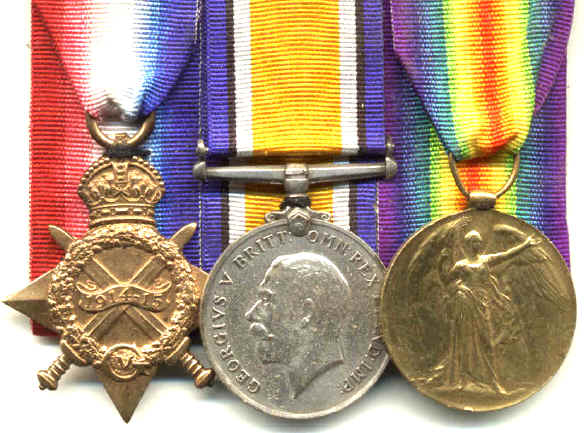 |
- A common group of medals
awarded to men who served in WW1
- 1914/15 Star
- British War Medal 1914/20
- Victory Medal (British
Empire version)
|
Throughout the war, a
substantial Citizen Military Force was maintained by universal service
as the 'home' component of the Australian Military Forces. 1921 marked
the post-war army reorganisation, by which AMF infantry regiments
were replaced by battalions modelled on, and numbered for, Australian
Imperial Force units.
In the period to 1939,
there occurred numerous unit linkings, expansions and contractions
responsive to national military training objectives and the country's
economic fortunes. Outbreak of the Second World War in 1939 not only saw
many peace-time militia battalions at significant strength but
also brought the decision, as in the Great War, to raise a (Second)
Australian Imperial Force for expeditionary service overseas.
A
total of eleven battalions having territorial association with New South
Wales served overseas in this Force, between 1939 and 1945, in North
Africa, Greece, Crete, Syria, Malaya, South West Pacific and Borneo.
As
the war spread to Australia's northern approaches, eight further
battalions (formerly militia, now redesignated AIF) saw hard fighting in
the South West Pacific area.
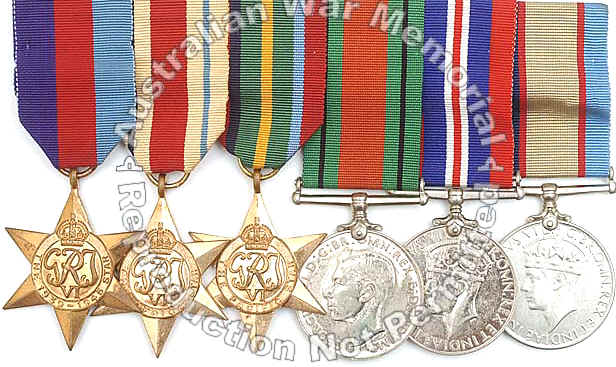 |
- A Group of medals common to
many of the men who served in WW2
- 1939/45 Star
- Africa Star
- Pacific Star
- Defence Medal
- British War Medal 1939/45
- Australia Service Medal
|
Once
again, Australia's infantry divisions' service stood well the test, in
every theatre of engagement, of upholding and enhancing the
distinguished reputation established by their Great War forebears.
On
the re‑raising of the Citizen Military Forces in 1948, a number of
territorially designated, relevantly numbered infantry
battalions were brought onto the Order of Battle in New South Wales. In
the period to 1960 also, a former Light Horse Regiment, (6th) now converted to
Infantry, brought ten additional Battle Honours, to add to those won by
the battalions.
As
a result of a major review, the Australian Army was restructured,
effective 1 July 1960, along lines known as 'Pentropic' and with line
infantry battalions designed to operate with other arms and services
with in 'Battle Groups'. The Citizen Military Forces' infantry
battalions in each State of the Commonwealth were grouped into
respective state regiments, thus the Royal New South Wales Regiment came
into existence on that date. It consisted of the following units:
-
1
RNSWR (Commando)
-
2RNSWR
-
3
RNSWR.
1
RNSWR was based in Sydney, generally drawing its specialist recruits
from the metropolitan area. The two line battalions' inter unit boundary
was generally Sydney Harbour and the Parramatta River, 2 RNSWR serving
the northern half of the State, 3 RNSWR the southern, in providing
opportunities for Citizen Military Force service in the corps of
Infantry.
A
number of re-groupings of the Regiment's size and structure have
occurred since raising, the first being on 1st July 1965,
with the move away from the Pentropic organisation, when 2 RNSWR split
to form 2 RNSWR and 17 RNSWR, and 3 RNSWR split to form 3 RNSWR and 4 RNSWR. At this time also, 41 RNSWR was formed from part of the 1st
Battalion, The Royal Queensland Regiment, in the Northern Rivers
district. 19 RNSWR, a 'Special Conditions 'battalion was raised in 1966
and on the Commando element leaving the Regiment on 1 May 197 1, became
1/19 RNSWR.
A
further reorganisation, on 1 July 1976, saw the now six battalions
placed under command, for administration and training, of a Headquarters
RNSWR, as HQ 2 Division became HQ 2 Division Field Force Group. This
structure terminated on 30 June 198 1, with HQ RNSWR becoming HQ 5 Task
Force, taking under command 1/19,3 and 14 RNSWR and HQ 8Task force being
established with under command 2, 17 and 41 RNSWR. Soon after this, the
formation designations were altered from 'Task Force' back to 'Brigade'.
Requirement
for the contraction of the infantry component of the Army led, in the
period September to December 1987, to the linking of some battalions,
with the resultant 5 Brigade commanding 1/19 and 4/3 RNSWR and 8
Brigade commanding 2/17 and 41 RNSWR. During 1995, battalions adjusted
to re-arranged home area and recruiting boundaries. |